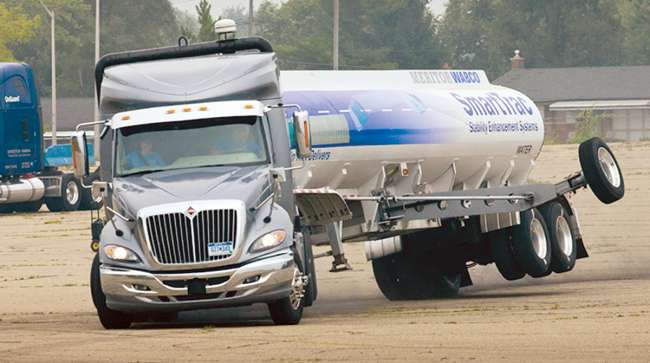Electronic Stability Control: A New Standard for Trucking Industry

All new Classes 7-8 tractors sold on or after Aug. 1 must be equipped with electronic stability control, which means that more fleets will need to understand how those systems work and how to maintain them.
ESC uses sensors to anticipate potential truck instability, such as an impending rollover, and automatically adjusts the throttle and the brakes to prevent an accident. The National Highway Traffic Safety Administration established its upcoming ESC mandate in a final rule published in June 2015.
While the technology itself largely is maintenance-free, fleets should carefully monitor the condition of related equipment to ensure the system performs properly, industry experts said.
“Certainly you want the brakes to be well-maintained, because that’s what ESC uses to control the vehicle in the case of an event,” said Brian Gigoux, vice president of equipment and maintenance for Groendyke Transport, a carrier based in Enid, Okla.
To maximize the potential of ESC, Gigoux recommends adhering to a comprehensive maintenance program that includes brakes, tires, compressed air systems and anti-lock braking systems. ABS is a key component of electronic stability control.
“ESC functions by sending brake signals through the ABS system,” said Carl Trabant, director of mechatronics engineering at Daimler Trucks North America. “Making sure that ABS is functioning and that brake pads are good and brake adjustment is correct are definitely required for ESC to function properly.”
Trabant also discussed mismatched tires. “Customers will need to be aware when changing tires on their vehicles since tire size is a parameter required for ESC to function properly,” he said. “A mismatch between front and rear tires could cause fault codes that disable the system.”
The main companies that manufacture ESC systems for the North American trucking industry are Bendix Commercial Vehicle Systems and Meritor Wabco Vehicle Control Systems. The Bendix product is Bendix ESP, and Meritor Wabco’s product is SmarTrac.
It’s important to keep brakes and tires in good shape, said Fred Andersky, director of government and industry affairs at Bendix.
“If you have good standard practices around [preventive] maintenance for the brakes, the stability system will be fine,” he said. “If your brake pads are worn or the brakes are not functioning fully, you’ll obviously have less braking power available than you would if all of those brakes were in good working order.”
The brake action is delivered by the tires, he said. “If your tires are low on pressure or your treads are worn out, again, the effectiveness of the stability system is reduced,” Andersky said.
Wheel ends and wheel bearings are other focal points for ESC-related maintenance.
“Any wheel end that runs with excessive end play may illuminate the ABS lamp and thus interfere with ESC operation,” said Jim Boyd, manager of fleet technical services at Southeastern Freight Lines, based in Lexington, S.C. “Technicians should be adequately trained on wheel-end systems to prevent not only ABS and ESC issues but also to mitigate a potential wheel-end separation issue.”
Robert Braswell, executive director of American Trucking Associations’ Technology & Maintenance Council, said wheel bearings are critical to proper braking control.
“Wheel bearings help position the wheel and influence the input to the wheel speed sensor,” he said. “If the bearing is out of adjustment, the inputs to the ESC can be inaccurate.”
Attention must be paid to fault codes and the air system used by the brakes, added Stu Russoli, highway product manager for Mack Trucks.
“Fleets need to make sure that air tanks are properly drained, air dryers are fully functional at removing moisture from the air and that any active anti-lock brake or ESC faults are addressed,” Russoli said. “The good news is that all of these maintenance activities are required for regular truck operation, so it should be easy for fleets to keep up with them.”
The SmarTrac maintenance manual from Meritor Wabco gives the ESC manufacturer’s recommendations for standard maintenance concerning brakes, ABS and tires, said Ryan Simmons, product marketing manager for Meritor Wabco. “Fleets report that SmarTrac is largely maintenance-free, and we don’t expect fleets or owner-operators to experience any new maintenance issues.”
Maintenance tasks generally fall within the normal required maintenance for trucks because much of the technology is not new.
“The stability control system relies on parts that have been on the truck for years, such as ABS,” said Bill Distel, director of product marketing at International Trucks, a brand of Navistar.
“It uses the brakes to control the vehicle, so brake maintenance is critical,” Distel said. “If a fleet is doing standard maintenance, such as keeping good tires on the trucks, maintaining the brakes and addressing any fault codes from the ABS sensors, then the electronic stability control system should work properly.”
One maintenance issue concerning the ESC components can arise if work is being done on the front end that affects the steer sensor used by the ESC.
“If repair work or adjustments are made to the steering system — steering component replacement or realignment, for example — the steering angle sensor would need to be recentered with an electronic command,” Mack’s Russoli said.
Andersky said realigning the Bendix ESP steer angle sensor is relatively easy. Fleets can use the company’s diagnostics software, which is a free download from the Bendix website, he said.
And fleet representatives report that the maintenance directly related to ESC components is minor.
“While electronic stability control is not perfectly trouble-free, it is pretty close,” Southeastern Freight Lines’ Boyd said. “Your technicians will not spend a lot of time working on these systems.”
Steve Page, vice president of safety for Transportation Distribution Co. in Joplin, Mo., said some adjustments were made in the beginning when the carrier first started using ESC. “But it has been largely maintenance-free,” he said.
Meanwhile, fleets also may encounter confusion concerning ESC maintenance if their drivers misread the way the truck responds in ESC-related events.
“Some drivers may start to complain about the brakes coming on or the throttle being cut when they’re going around turns or something similar,” Andersky said.
Drivers need to be aware that the ESC is taking control of the throttle and brakes in order to prevent an accident.
“It’s possible that some of these drivers have repeatedly been close to a rollover or loss of control but have barely avoided a crash without realizing it,” Andersky said. “The system is telling the driver, ‘Hey, you’ve been going around that turn a little too fast. Time to slow it down.’ ”
Boyd said that if drivers misinterpret the truck’s behavior, fleet maintenance can be looking for mechanical problems that don’t exist.
“Technicians need to be trained to distinguish between maintenance problems and driver problems,” he said. “You don’t want your maintenance department to be working on a vehicle for a supposed brake problem or low-engine-power problem, when in reality the ESC is performing as it is intended, but the driver does not understand this and reports a condition such as a brake problem or engine-related problem.”
“Overly aggressive or distracted drivers will immediately know that a vehicle is ESC-equipped because the system will de-rate the engine or make a brake application or do both to mitigate a potential accident,” Boyd said
On the other hand, ESC may not come into play with careful drivers.
“Skilled and safe drivers may never know their truck is equipped with ESC,” Groendyke Transport’s Gigoux said, “but it’s always there working for them if needed.”
Adjusting to ESC is simpler than the previous transition to ABS. “When ABS came in 20 years ago, you had to teach the drivers to keep steady pressure on the brake pedal,” International’s Distel said. “You didn’t want them to pump the brakes, because that would mitigate the effectiveness of the anti-lock braking system.”
“With ESC, you don’t have to give the driver any additional instructions, because it works in the background,” he said. “Sometimes drivers don’t even know that stability control is helping them. The driver may be thinking the situation is not that bad, but the system is already taking action to prevent an accident.”
Kenworth, a unit of Paccar, declined to comment for this story. Attempts to speak with Peterbilt, also a unit of Paccar, weren’t successful.


